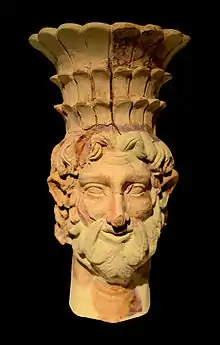Baal Hammon
Baal Hammon, properly Baʿal Ḥammon or English: “Lord Hammon” Ḥamon (Phoenician: 𐤁𐤏𐤋 𐤇𐤌𐤍 baʿl ḥamūn; Punic: bʻl ḥmn),[1] was the chief god of Ancient Carthage. He was a weather god considered responsible for the fertility of vegetation and esteemed as King of the Gods. He was depicted as a bearded older man with curling ram's horns.[2] Baʿal Ḥammon's female cult partner was Tanit.[3]
| Baʿal Ḥammon | |
|---|---|
 Statue of Baʿal Hammon on his throne with a crown and flanked by sphinges, 1st century. | |
| Consort | Tanit |
| Greek equivalent | Cronus |
| Roman equivalent | Saturn |
| Canaanite equivalent | El |
Etymology
He is clearly identified as one of the Phoenician deities covered under the name of Baal.[4] However, the meaning of his second name is unclear. Frank Moore Cross argued for a connection to Hamōn, the Ugaritic name for Mount Amanus, a peak in the Nur Mountains which separate Syria from Cilicia.[5] In the 19th century, when Ernest Renan excavated the ruins of Hammon (Ḥammon), the modern Umm al-‘Awamid between Tyre and Acre, he found two Phoenician inscriptions dedicated to El-Hammon.[6] Others have proposed Hammon as a syncretic association with Libyan-Egyptian god Amun,[7] while a last current has called instead for a connection with the Northwest Semitic word ḥammān ("brazier"), suggesting the sense "Lord of the Brazier".[6]
Cult and attributes
The worship of Baʿal Hammon flourished in the Phoenician colony of Carthage. His supremacy among the Carthaginian gods is believed to date to the fifth century BC, after relations between Carthage and Tyre were broken off at the time of the Battle of Himera (480 BC).[8] Baal Hammon was known as the Chief of the pantheon of Carthage and the deity that made vegetation grow; as with most deities of Carthage, his powers relied on child sacrifice.[9]
He has been identified with a solar deity,[6] although Yigael Yadin thought him to be a moon god. Edward Lipinski identifies him with the god Dagon.[10] In Carthage and North Africa Baʿal Hammon was especially associated with the ram and was worshiped also as Baʿal Qarnaim ("Lord of Two Horns") in an open-air sanctuary at Jebel Boukornine ("the two-horned hill") across the bay from Carthage, in Tunisia.[11]
The interpretatio graeca identified him with the Titan Cronus. In ancient Rome, he was identified with Saturn, and the cultural exchange between Rome and Carthage as a result of the Second Punic War may have influenced the development of the festival of Saturnalia.[12]
Greco-Roman sources report that the Carthaginians burned their children as offerings to Baʿal Hammon. (See "Moloch" for a discussion of these traditions and conflicting thoughts on the matter.) Attributes of his Romanized form as an African Saturn indicate that Hammon (Amunus in Philo's work) was a fertility god.[13]

Location
Ba'al Hamon was a place mentioned in the Song of Solomon.[14] It was the location of a productive vineyard owned by Solomon, who let out the vineyard to tenants, each of whom was to bring him a thousand silver shekels. The locale has been supposed to be identical with Baal-gad, and also with Hammon in the tribe of Asher.[15]
See also
References
- Krahmalkov, Charles R. (2000). Phoenician-Punic Dictionary. Leuven: Peeters. p. 113. ISBN 90-429-0770-3.
- Brouillet, Monique Seefried, ed. From Hannibal to Saint Augustine: Ancient Art of North Africa from the Musee du Louvre. Michael C. Carlos Museum, Emory University: Atlanta GA, 1994.
- Serge Lancel. Carthage: A History. p. 195.
- "Carthaginian Religion". Ancient History Encyclopedia. Retrieved 2017-08-04.
- Cross, Frank Moore (1973). Canaanite Myth and Hebrew Epic. Harvard University Press. p. 26-28. ISBN 9780674091764. Retrieved 19 January 2017.
- Walbank, Frank William (1979). A Historical Commentary on Polybius, Volume 2, Clarendon Press, p. 47
- S. G. F. Brandon, Dictionary of Comparative Religion, 1970, Littlehampton, 978-0297000440
- Moscati, Sabatino (2001). The Phoenicians. Tauris, p. 132. ISBN 1-85043-533-2
- Kennedy, Maev. "Carthaginians sacrificed own children, archaeologists say". The Guardian. Retrieved 19 May 2020.
- Edward Lipinski, Dictionnaire de la civilisation phenicienne et punique (1992: ISBN 2-503-50033-1).
- Roberto Peter Bongiovanni (2014). "The Interchange of Plain Velar and Aspirate in Kronos/Chronos: A Case for Etymological Equivalence". Master's thesis at City University of New York.
- Robert E.A. Palmer, Rome and Carthage at Peace (Franz Steiner, 1997), pp. 63–64.
- Serge Lancel (1995). Carthage: A History, p197.
- Song of Solomon 8:11.
- Joshua 19:28
External links
| Wikimedia Commons has media related to Baal Hammon. |
- On-line parallel Bible: Song of Solomon 8:11